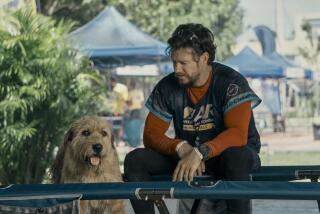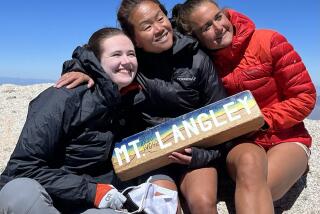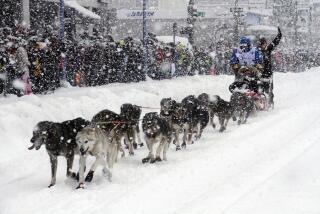Her Dogs Come First : Butcher Is Way Out There as Best in Iditarod
Alaska--Where Men are Men and Women Win the Iditarod.--Souvenir T-shirt.
Susan Butcher admits she hasn’t paid much attention to the Winter Olympics.
“Actually not,” she said by phone from Fairbanks, Alaska. “We don’t have any TV out there.”
“Out there” is Eureka, an village northwest of Fairbanks near the Yukon River where there not only is no television but no phone and no freeways. No foolin’.
Out there, the Winter Olympics seem a bit tame.
At Calgary, it’s all downhill for Pirmin Zurbriggen, a slide on ice for Brian and Brian, and where were all those biathletes when Butcher needed one to shoot a moose she met on her trail once?
Butcher, 33, does her thing without flags or fanfare and does it better than anyone else on earth. She never wanted to figure skate in a frilly costume the size of a snowflake or ride a luge down a flume in a plastic leotard.
All she ever wanted to be was the world’s top sled dog musher, and she is--the inspiration for T-shirts and certainly a woman apart from her peers, male and female.
After winning the Iditarod race from Anchorage to Nome the last two years, Butcher’s place in the pantheon of mushing is assured. She’ll try for three in a row, starting March 5.
Still, an Olympic gold medal . . .
“I would love to see the sport in there,” she said. “I think it should be. It was in one of the Olympics way back.
“I think the issue of amateur vs. professional has to be dealt with before they can allow it in there. There are no amateur dog mushers because of the expense. It’s probably going to be a demonstration sport in the ’96 Olympics. There’s a very good chance they’re gonna be here in Alaska (at Anchorage.)”
Meanwhile, she is content to perform not on manicured trails, well-marked and guarded from the elements, but in a frozen wilderness exposed to everything nature can throw at her.
You want wind? Try up to 100 m.p.h.
Cold? As low as 50 below.
And who ordered moose?
Butcher, who raced in her first Iditarod in 1978, has finished in the top five every year since ‘80, except in ’85. That year she was leading in the early stages when she met a moose on the trail. It wasn’t Bullwinkle.
Normally, a moose will amble off at the approach of a human, but this one was looking for trouble. A few frantic minutes later, two of Butcher’s dogs were dead, others injured and she was out of the race.
Libby Riddles went on to win, starting the string of three straight victories by women.
The race alternates between a northern and southern route each year. Last year Butcher broke her own record by finishing in 11 days 2 hours 5 minutes, and that was on the longer southern course measuring 1,157 miles--not exactly a sleigh ride in Vermont.
This year she gets a break. The northern route measures only 1,152 miles, with 25 checkpoints where she and the dogs can rest, in case they get tired.
“That is the most crucial aspect of the strategy,” Butcher said. “I give my dogs at least 12 out of every 24 hours of rest.”
And the last time Butcher passed through there were no Holiday Inns along the way--not even a fireplug--and while the dogs are resting, she’s working. Rules prohibit anyone but the mushers to care for their own dogs and equipment.
“We’ll run for four hours and stop for four hours,” Butcher said, “during which time I have to bed them down on spruce boughs, start a fire, melt the snow, cook for them, feed them, take care of the equipment.
“You have to be very selfless in your dedication to your dogs. When you come into a checkpoint, although there may be a warm cup of tea waiting for you inside and a wood stove to warm your feet by, you stay outside, you take care of your dogs, get them completely bedded down and fed. It may take three hours.
“Then you can go have your 15 minutes inside, and then it’s time to go check your dogs, massage them down and get ready to go again. I might get a catnap.
“But if you don’t do that, you’re gonna lose the race.”
For the mushers, it’s a dog’s life. They don’t even get to ride on the sled much.
At a pace of 8 or 9 m.p.h., “You do some riding that can be fairly relaxing but the majority of it you’re either pumping with one leg or running,” Butcher said.
“The most strenuous is going over the rough terrain and having to steer the sled, which weighs from 150 to 200 pounds with all the gear in it. Throwing the sled around is as exhausting as pumping or running.
“Running behind is really nice for a number of reasons. You keep warm that way. You can stay awake that way. A lot of times I’ll get off and run just to wake myself up.”
After nearly two weeks of that, it must be nice to get home to all the comforts. Butcher goes home to Eureka, where she and her husband, David Monson, a lawyer who is also a musher, run Trailbreaker Kennels, currently with 150 dogs in residence.
“Until a couple years ago, we did without electricity and, of course, running water,” she said. “Heat with wood. We now have a generator, and we have a dog (food)-mixing shed that has running water in it. We still don’t have running water in the house, but that’s secondary compared to the needs of the dogs.”
Butcher, an athletic 5 feet 6 inches and 135 pounds, was raised in Cambridge, Mass., but explained, “This is the life I chose.”
She will start the race with 16 or 18 dogs, each with its own personality and often a mind of its own. Some will be dropped off at checkpoints as the race progresses.
All are Alaskan Huskies, the females weighing 40 to 50 pounds, the males 50 to 60.
“They’re fun to be with,” Butcher said. “Some are funny. Some are serious. They make wonderful household pets. I’ve given many away. They’re wonderful with children. They’re very intelligent.”
She has no favorite.
“It’s like asking a person with 10 kids which is their favorite child,” she said.
But her best lead dogs currently are Granite and Tolstoy, each of whom has led her to recent, record victories in 300- and 250-mile races.
Like all the dogs, Butcher said, “They live to race. They like the competition. They understand the competition. They want to pass the teams ahead of them. They know when there are no dogs on the trail ahead of them.
“The biggest problem is slowing them down. In 1986, I ran four races. That’s more races than any long-distance racer has ever run, and I now know why--2,250 miles of races, which didn’t include my 3,000 miles of training.
“Only one dog ran all four races, but many of them ran three. I was going into my fourth race thinking, gosh, I’m really burnt out, so these dogs must be real burnt out, too.
“It was a 350-mile race, and I had absolutely no control of that team. I could not get them to stop. I was hooking trees with our snow hook, and they were tearing them over. This team was just crazy to go. They wanted to see what’s around the next corner. They wanted to race.
“You have to run all of them at the same time. You need only one to three dogs to pull you and the sled and the gear, so it’s way overkill, and you have all this immense amount of power. You’ve got nothing but a voice command. There are no reins or anything. It’s all ‘gee’ for right, ‘haw’ for left, ‘whoa.’
“These have to be highly trained individuals. It’s instinctive for them to pull. They’re trained and ready for it.
“You couldn’t take Fifi the poodle out of somebody’s apartment in New York and expect her to run the Iditarod, but you sure as heck could take one of these dogs that was raised from a puppy. They’re ready for the Iditarod, and they just love it.”
Their instincts also are convenient. One time Butcher’s lead dog, Tekla, insisted on going right when Butcher wanted to go left. Seconds later, the trail they had been on collapsed into a running river.
“Tekla saved our lives,” Butcher said.
“I spend all my time working on the dog aspect. Other people get stuck on working on better equipment, or they think there’s some key secret--a better strategy or something.
“You have to be a good strategist, but the most important thing is the dogs--raising the best dogs, training them the best, giving them the best nutrition and the best veterinary care.”
One senses, here comes the commercial. Butcher is sponsored by a pet-food company.
“I raise all my own dogs,” she said. “I start them right off the bat on the best food possible.
“Good nutrition for even a pet dog is just as important as it is for my dogs. A lot of it was started by the human athletes, and the normal person started realizing, ‘Hey, if I eat a better diet I’m gonna feel better.’ It’s the same with dogs.”
If this sounds as if she’s mushing down Madison Avenue, she doesn’t apologize.
“Our sport is so expensive, to supplement my income of dog sales and prize money, I need a sponsor,” she said.
First place in the Iditarod is worth $50,000. No gold medals, but Butcher knows how, say, U.S. figure skater Debi Thomas feels this week.
“The pressure’s on me, and I don’t mind the pressure at all,” Butcher said.
More to Read
Sign up for Essential California
The most important California stories and recommendations in your inbox every morning.
You may occasionally receive promotional content from the Los Angeles Times.










